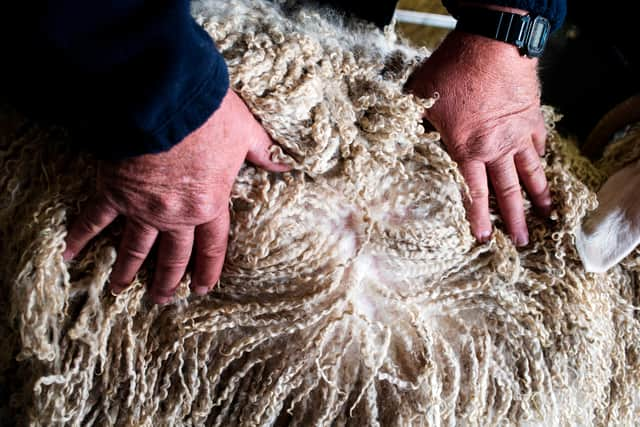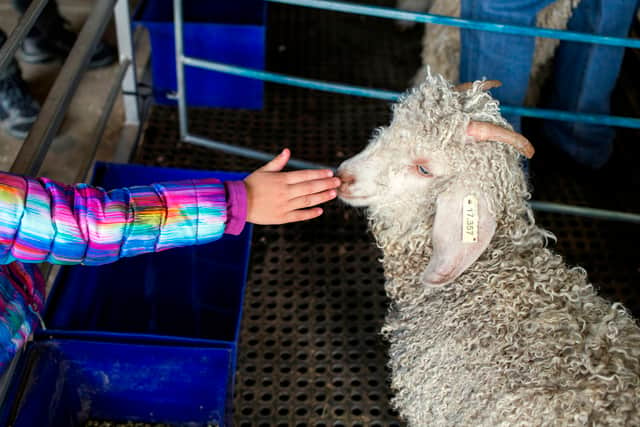Mohair wool: what is it, how is it obtained from goats, where does it come from - as Lineker suit criticised
This article contains affiliate links. We may earn a small commission on items purchased through this article, but that does not affect our editorial judgement.
and live on Freeview channel 276
Peta has criticised Gary Lineker's clothing line for featuring a mohair suit.
The animal rights group say the £225 Italian Mohair slim-fit suit by Signature Barberis - seen modelled by the BBC sports broadcaster in online advertisements - is "profiteering" from mohair, a controversial wool from Angora goats that is harvested via methods they say are "cruel and inhumane."
Advertisement
Hide AdAdvertisement
Hide AdThe suit is a component of Lineker's fashion "edit" for high-street clothing retailer Next; many high-street stores, including Marks & Spencer, Zara, H&M, and Gap, have banned the material.
But what exactly is mohair, and why is it considered so controversial? Here is everything you need to know.
What is mohair?


Mohair is a type of fabric or textile material that is made from the hair of the Angora goat. It is known for its distinct properties and is valued for its softness, lustre and durability. Mohair fibres are smoother and finer than many other natural fibres, which gives mohair fabric a unique sheen and a luxurious feel.
Mohair is often used in the production of various products, including clothing (such as sweaters, scarves and coats), upholstery, blankets, and even stuffed animals or dolls. It can be blended with other fibres like wool or silk to create different textures and enhance its properties.
Advertisement
Hide AdAdvertisement
Hide AdOne of the distinctive features of mohair is its ability to take dye exceptionally well, resulting in vibrant and richly coloured fabrics. However, mohair can also be sensitive to certain factors such as sunlight and excessive moisture, so proper care is necessary to maintain its quality.
The term "mohair" can also refer to the actual hair or fleece of the Angora goat before it is processed into fabric. The Angora goat is known for its long, silky, and curly hair, which is shorn and then processed to create mohair textiles.


South Africa is the largest producer of mohair globally and is renowned for producing high-quality mohair fibres. The Angora goat industry is well-established in various regions of the country.
Other countries like Turkey, the US - particularly Texas - Argentina, New Zealand, and Australia also contribute to the global production of mohair
Advertisement
Hide AdAdvertisement
Hide AdWhy has it been criticised?
The production of mohair has been a topic of ethical and sustainability concerns in recent years, particularly related to animal welfare and the treatment of Angora goats.
There have been instances of poor treatment and unethical practices within the mohair industry, which have raised concerns about the well-being of the goats involved.
In some cases, Angora goats have been subjected to inhumane treatment, including rough handling during shearing, which can lead to stress, injuries and discomfort. Improper shearing techniques can also cause cuts, abrasions and other injuries to the goats.


Yvonne Taylor, Peta’s vice president of corporate projects, said: "Most shoppers would be disgusted that mohair jumpers and suits are made from the hair of abused goats who cry out in fear when they are pinned down.
Advertisement
Hide AdAdvertisement
Hide Ad"Their hair is scraped right out of their bodies with metal rakes, leaving them shaking and covered in bloody wounds. Goats are prey animals and are terrified of being held immobile, vulnerable and defenceless."
Concerns have also been raised about inadequate living conditions for Angora goats, including overcrowded and unsanitary environments, lack of proper shelter, and limited access to clean water and nutritious food.
Then there is the issue of mulesing, a controversial practice in some regions where sections of skin are removed from the goats' hindquarters to reduce the risk of flystrike.
Flystrike can cause severe harm and potential death if left untreated, but the mulesing procedure is painful and has sparked significant ethical concerns.
Advertisement
Hide AdAdvertisement
Hide AdThe environmental impact of Angora goat farming can also be a concern, particularly if unsustainable farming practices are used.
Mohair production requires grazing land for Angora goats, which can lead to deforestation, habitat degradation and competition with other land uses, potentially impacting local ecosystems and biodiversity.
Overgrazing can also lead to soil erosion, degradation and reduced soil fertility, affecting the long-term sustainability of the land. Furthermore, the use of pesticides, fertilisers, and other chemicals in mohair farming can lead to soil and water pollution, potentially harming local ecosystems and aquatic life.
Mohair production can also be a water-intensive practice, especially in regions where water resources are already stressed. High water consumption for irrigation and animal hydration can contribute to water scarcity and affect local water availability.
Advertisement
Hide AdAdvertisement
Hide AdWhat can I do to help?
Though efforts are being made within the industry to address these concerns and improve the ethical and sustainable practices associated with mohair production - like rotational grazing, soil conservation techniques and reduced chemical use - campaigners argue there is insufficient oversight and regulation in some parts of the mohair industry.
They have also criticised a lack of transparency in the supply chain, making it difficult for consumers to know whether the mohair products they purchase are ethically sourced.
Of course, just avoiding and not buying mohair products is a proactive step consumers can take to limit the demand for mohair. By choosing not to support the mohair industry, you send a signal to producers and retailers that there is reduced demand for products made from Angora goat fibres.
But, if you really must have a new, mohair suit, there are several factors you can consider when purchasing mohair products to ensure they are made ethically and sustainably.
Advertisement
Hide AdAdvertisement
Hide AdLook for mohair products that carry certifications or labels indicating ethical and sustainable production practices. One such certification is the Responsible Mohair Standard, which sets guidelines for animal welfare, environmental responsibility, and traceability in mohair production.
Choose brands and products that provide transparent information about their supply chain, including details about the farms and practices involved in mohair production. Brands that are open about their sourcing and production processes are often more likely to prioritise ethical and sustainable practices.
You could also look for information about sustainable farming methods, reduced chemical use, and efforts to minimise the ecological footprint of mohair production, and products that can be traced back to specific farms or regions are often more accountable for their sourcing practices.
Comment Guidelines
National World encourages reader discussion on our stories. User feedback, insights and back-and-forth exchanges add a rich layer of context to reporting. Please review our Community Guidelines before commenting.
